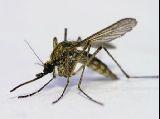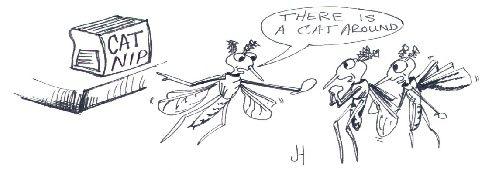Natural Solutions to Things That Bug You (59 page)
Read Natural Solutions to Things That Bug You Online
Authors: Myles Bader

The mature mosquito breeds, feeds, and dies within a week or two, which is the life cycle of most mosquitoes. This mosquito is the primary and secondary vectors for dengue fever. Aedes is the most important vector in the tropics and subtropical regions such as the southern United States.
Eggs of these mosquitoes; typically are laid singly or in rafts and although they may stick to the surface, they may sink if the water is disturbed. They prefer clean water for the development of the larvae and in tropical areas they will develop in water pots and tanks on roofs and in rain butts.
Feeding is described as endophagic because the mosquito prefers to feed in and around structures and the mosquito then rests in cool damp spots within structures while the meal is digested (endophilic behavior). A blood meal takes 2-7 days to digest and 1-3 meals are needed to complete development of clutch of eggs. Transmission between humans comes from repeated biting when the mosquito injects saliva that acts as an anticoagulant.
ANOPHELES MOSQUITO
 The Anopheles Mosquito is different from other types of mosquitoes as it is the genus most accountable for spreading malaria to humans. Malaria can be fatal; its typical symptoms include fever, headaches, chills, and general flu symptoms. The species of Anopheles known as Gambiae is infamous for transmitting plasmodium falciparum, the most threatening form of malaria in the world.
The Anopheles Mosquito is different from other types of mosquitoes as it is the genus most accountable for spreading malaria to humans. Malaria can be fatal; its typical symptoms include fever, headaches, chills, and general flu symptoms. The species of Anopheles known as Gambiae is infamous for transmitting plasmodium falciparum, the most threatening form of malaria in the world.
The Anopheles mosquito is generally located near bodies of water, such as ponds, swamps, marches, ditches, and rain pools. The Anopheles female favors laying its eggs in fairly still water that is oxygenated, and where there is an abundance of wild plant life. Some species enjoy the shady areas, while others prefer sunlight.
Malaria is transmitted between people by female Anopheles mosquitoes, and more than 60 species have been incriminated in the transmission of infection (there are about 430 species of Anopheles and about 3500 species of total species of mosquitoes).
Some species are more significant than others as vectors because of variations in susceptibility to the parasite or the propensity of the mosquito to bite humans and to enter houses when looking for a blood meal.
Females lay their eggs in batches of 70-100 on the surface of water at night. The type of water used for egg laying is indicative of the mosquito species and includes irrigation channels, a pool of water in a tree trunk, and sewage effluent. In tropical temperatures the eggs hatch after two to three days.
The larvae lie just below the surface of the water and feed on algae, and after 7-14 days turn into pupae during a five-minute process. The pupa is comma-shaped and is the least active stage of the Anopheles lifecycle. After two to four days the pupa metamorphoses into an adult mosquito. The adults emerge during late evening and are able to fly within minutes.
CULEX MOSQUITO
The Culex Mosquito can be considered the least dangerous of the three major types of mosquitoes due to the fact that humans are not their preferred blood meal. Instead, most species of Culex are partial to biting birds rather than humans. Despite this inclination, the Culex female mosquito is nevertheless recognized as spreading diseases such as the West Nile virus, malaria, filariasis, and encephalitis.
dangerous of the three major types of mosquitoes due to the fact that humans are not their preferred blood meal. Instead, most species of Culex are partial to biting birds rather than humans. Despite this inclination, the Culex female mosquito is nevertheless recognized as spreading diseases such as the West Nile virus, malaria, filariasis, and encephalitis.
The Culex, like the Anopheles, tends to favor standing water to lay its eggs; however, unlike the Anopheles, it does not necessarily opt for plant and wild life surroundings. Instead, it often breeds in the outdoor objects on your property, such as barrels, cans, garden pots, used tires, as well as other places where stagnant water can collect.
NATURAL METHODS OF ELIMINATION
NUMERO UNO MOSQUITO KILLER
If you don’t have a cat this is the best mosquito killer that is available. Catnip placed in a sachet and placed around the home will deter any and all mosquitoes in short order. Catnip contains the essential oil nepetalactone, which is at least 10 times more powerful than any commercial mosquito killing solution. A tea made from catnip can also be placed into a spray bottle and sprayed anywhere you have a problem.

MOSQUITO REPELLANT 1
The following ingredients will be needed:
1 Ounce of oil of citronella (from health food store)
1 Drops of corn oil
Place the ingredients in a small bowl and mix well. Rub the mixture on your skin before going into mosquito-land.
SOLUTION FROM INDIA
A natural vegetable oil that is extracted from an Indian tree called the “Neem tree” is very effective in repelling mosquitoes. The seeds and the leaves contain the chemical sallanin, which has been used for hundreds of years in India to repel flying insects. It is natural and more effective than any commercial product on the market. One Internet site to get the product is
www.nutraceutic.com
.
HERBS 101
To get rid of flying insects, just place some fresh basil in a muslin bag or two and hang them around the house or on the porch. Flying insects do not like the smell of basil and it will repel almost every flying insect.
MOSQUITO REPELLANT 2
The following ingredients will be needed:

3 Cups of rubbing alcohol
1 ½ Cups of red cedar wood shavings
½ Cup of eucalyptus leaves
1 Spray bottle
Place all the ingredients in a large bowl and mix well. Cover the bowl and allow it to stand for 6 days before straining the solution through a piece of cheesecloth. Place the liquid in a small spray bottle and spray on skin as needed.
MOSQUITO REPELLANT 3 FOR ARMS AND LEGS
The following ingredients will be needed:
4 Parts glycerin (from pharmacy)
1 Part eucalyptus oil
Place the ingredients into a small bowl and mix thoroughly. Place in a well-sealed container. Rub a small amount on arms or legs to keep mosquitoes from biting.
WATER, WATER, EVERYWHERE
Be sure that there is no standing water anywhere on your property. Mosquitoes like pets, water dishes and birdbaths. If you sprinkler system is leaving a puddle that does not dry up in a short period of time, be sure and fix it.
REPEL MOSQUITOES WITH YOUR BARBECUE
It doesn’t matter if you use real charcoal or artificial charcoal, just place a few sprigs of rosemary or sage on top of the coals and you won’t see a mosquito for some time.

GETS RID OF VAMPIRES AND MOSQUITOES
Mix 1 part of concentrated garlic juice with 5 parts of water and place it in a spray bottle. Spray in any area that they frequent. This treatment will be effective for 5-6 hours and you will have great smelling mosquitoes.
A GRASS THAT REPELS MOSQUITOES
A very effective substance that repels mosquitoes is citronella. Citronella can be found in lemon grass and in the natural oil form, found in the grass, which is even more effective than the citronella that you purchase from the store. It is also called Thai grass and is available at most garden stores.
Use the scallion-like stem of the plant, crush it and use it on your arms, legs and neck to repel mosquitoes. You can also make a spray by making a tea from the stem.
SCARE THEM AWAY WITH BEANS
If you want an easy solution to ridding your home and garden of mosquitoes, just purchase some castor bean seeds and grow a few plants. Castor bean plants grow like weeds and will repel mosquitoes. The chemical in the castor bean is ricinine and when extracted it is a deadly chemical.
GROW SOME BAMBOO PLANTS
Dragonflies are attracted by bamboo plants and are safe around people. They like to live among the long bamboo shoots in warm and sunny areas of your yard. One dragonfly will consume at least 100 mosquitoes in 30 minutes and will eat their larvae as well.
They can spot a mosquito 25 yards away and go after it at 60 miles per hour. Dragonflies can be found in most areas of the United States.
GET BATS IN YOUR BELFRY
If you don’t have bats in your neighborhood you might consider purchasing a bat house. Most garden supply stores will sell a bat house for about $25.00.
